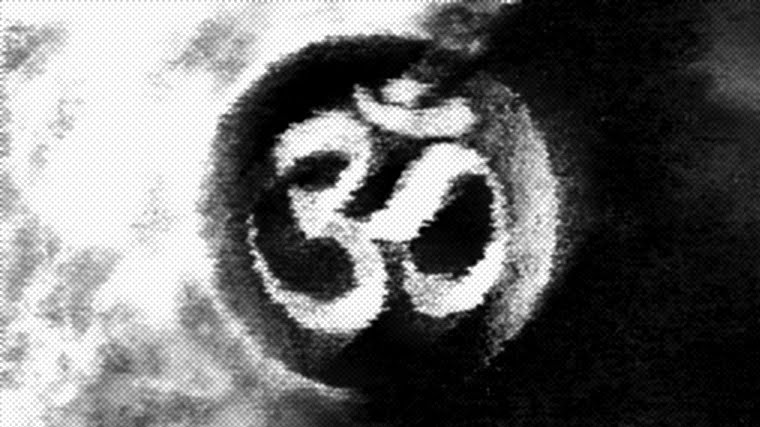It must had been primarily hard for a mystic – among mystics – such as Patañjali to dress into words the understanding of experience(s) beyond the realm of immediate perception, which in a sense justifies the use of laconic language that most of the times baffles the contemporary reader. The knowledge that this ancient mystic is trying to articulate in the sūtras falls into the buffer or grey zone that forms the perimeter of the human cognitive perception amidst the chaos of concepts beyond our mental understanding[1],[2]: this area can be rendered as the circumference of a cycle tainted with emotional-dreamy traits[3] [see fig. a01]. Despite our inability to articulate them, we as humans are able to physiologically grasp them by means of bodily experiential feedback. Even more so, we still possess the capacities to engage with them emotionally or develop an inherent understanding through self-reflection and dialectics. The latter, is a process that was initiated through the implementation and re-reading of the original text that lead into various approaches or descriptions known as commentaries or Bhāṣya-s.
fig. a01 the Realm of Cognitive Awareness [visualisation based on J Peterson's Biblical Lectures Youtube]
Back then Patañjali’s efforts to unite the shambolic ideological systems that had sprung from the earlier yoga traditions must have been a rather strenuous task. The natural, inherent tendency that we possess as humans, to cling into ideologies and self-proclaim ourselves protectors of their constricted boundaries had been immanent all around the world that Patañjali used to live in – gravely separating instead of uniting the human spirit in order to bring about something good[4]. The values of the compiled aphorisms were not a by-product of logical thinking but the fruits of a journey into the dreamy realm[5],[6].
Trying to make sense of the Yogasūtra-s only as a piece of literature will naturally constrict us to our narrow sphere of apprehension that is established onto things of non-firm, non-conceivable reality[7] – one will eventually act out dreams that she / he does not feel, stemming from an internal disassociation. In order to grok their meaning, studying and reading the text itself will be of little value; humans have a tendency to read and apprehend a lot, but are usually found to act along a vector pointing toward a diametrically opposite direction. Thus, practice is paramount i.e. the physical and physiological experience of the described axioms as perceived by the most apt, tangible parts of our bodies and senses.
The importance of the text draws even further on. There are very clear references to what Freud conceptualized as the subconscious mind, conceptualized as God in the ancient times; an obscure layer that overrides our voluntary control mechanisms and seems to indirectly affect our conscious decisions. This idea is then transcended into the psychoanalytical concept of the human being as a fragmented puzzle of personalities with independent characteristics of which jurisdiction can hardly be applied successfully.
The ineptitude to curb and discipline oneself can be magnified in the contemporary world due to the enhanced stimuli which in turn seem to be working on the unconscious mind. The very early eras of human existence that preceded Patañjali were lacking such context, and thus made it easier for people to be in closer contact with the divine [read subconscious mind]. Disassociated from the intimidating self-imposed artificial reality, early humans found solace in nature and further on through the overwhelming, altruistic offering of her juices that were amply used to mingle the human consciousness with the divine. Long-extinct plants such as soma were the primary means of melting the concreteness of reality, fusing it into the spiritual realm[8]. God, and whatever can be framed inside this notion, was manifested in the human soul, erasing any need of scripting down in literary form the rules and principles that helped toward this path.
Ideologies are parasites on an underground religious [do you mean spiritual?] substratum according to which people are trying to organise their thinking; they are likened to crippled religions, wrapped and twisted, falsely representing a pure but yet inconceivable foundation. Nietzsche proved that when the aforementioned substratum is diffused, humanity is oscillating into extremes, magnificently represented by the clash of polarized ideological strongholds. On top of that, he thoroughly predicted the loss of millions of lives in contemporary societies, that followed the efforts to rationally interpret the dreamy or emotional states with faulty rational representations(?).
Little information can be obtained on the history that preceded Patañjali and the practices of yoga amidst the vedic periods [vedanet.com the original teachings of yoga: from Patañjali back to Hiranyagarbha[9]]; the very fact of the traditions’ oral character combined with our failure to sustain enough scriptural evidence makes the investigation as to what had been practically going on, even harder. Assuming that there has been worshiping of multiple different deities and thus, various corresponding representative schools – which were actually teaching the same thing in different forms - paints an image of Patañjali as a peacemaker amidst the chaos: one could easily draw connections to the role that Moses played during the Jews spiritual and physical wandering in the desert i.e. both men were encouraged to compile a set of rules, commands [in the case of Moses] or aphorisms [in the case of Patañjali] that bound the spiritual cosmonauts into a united philosophical common-ground that was fundamental in order to settle and progress through the coming eons not as fragmented sub-groups but through strength-by-unity.
[1] This can be simply viewed as a misty realm for which nothing is known at all.
[2] Contemporaries of Patañjali have also fallen into the same trap when trying to explain something beyond human apprehension: a common example would be the translation of 4th dimension into words and / or images, a task usually performed by artists or writers with debatable results. Still, although the point is taken for granted, the actual experience is hardly generated.
[3] This is the realm into which the mystics and artists live or pay visit when the situation demands – they are the mediators between the unknown and what we know for sure. Although incomprehensible at first, it is possible to be rendered by employing anything humanly invented especially by means of art. Words and text is always harder to carry the meaning as such, since logos is already infected by humane memories and preconceived notions or ideas in its very essence.
[4] Even nowadays, people around the Indian subcontinent find themselves disputing and arguing over their god-centred belief systems – with discussions leading up to misunderstandings and even brawls; there is hardly any difference when such phenomena are multiplied in global scale.
[5] This grey area has been shaping itself since always by the extrapolation of empirical, behavioural knowledge of humanity by means of art, literature, mythology etc and as such is constituent in aiding us understand ourselves and why act the way we do. Yoga as such, provides the student with a key to open the doors of this unknown realm that seem to have been informed with the principles that shape our very human nature – and this justifies the very fact that many of her researchers have come to describe regularly as a form of art. This is what is also suggest by Joseph Campbell too [see Mythos II, ep 2]
[6] as a yogi and physicist liked to point out to me, it is an action that very much resembles the digital cloud principles, into which one is able to connect to, find what he is looking for and then download it back into reality as we experience; these truths and values had always been there, and they will always remain there intact, so that the mediators will be able to access them, when the times demand to do so. This is also proving – up to a certain degree – how detached this entire process is, compared to the superhuman aka überman concept as developed by Nietzsche – the axioms are not developed by humans who are looking towards becoming god themselves. Although people need belief-systems in order to exist and maintain psychological and sociological stability, they usually incorporate such rigidity that turn their supporters into a raging, totalitarian, blood-thirsty mob.
[7] One can alternatively picture this as a castle built upon moving sand i.e. unsteady foundations; living in such a place or simply trying to raise it in the first place would be impossible based on our development as a species.
[8] The ambiguity of Vedic traditions and texts cannot solidly draw any conclusion as to which plants were used for the extracting of the sacred juice – that very much resembles practices of later customs found in the Amazon – but the significance of soma was disseminated through linguistics into the same ancient Greek word that translates as (human) body: the annihilation of the source-plant forced humanity to use and manipulate the human body as such, in order to extract the necessary liquid substance that will journey the mind to its very origin, according to Richard Freeman’s poetic account of events in the Yoga Matrix.
[9] source: https://www.vedanet.com/the-original-teachings-of-yoga-from-patanjali-back-to-hiranyagarbha/ accessed June 18, 2020.



No comments:
Post a Comment